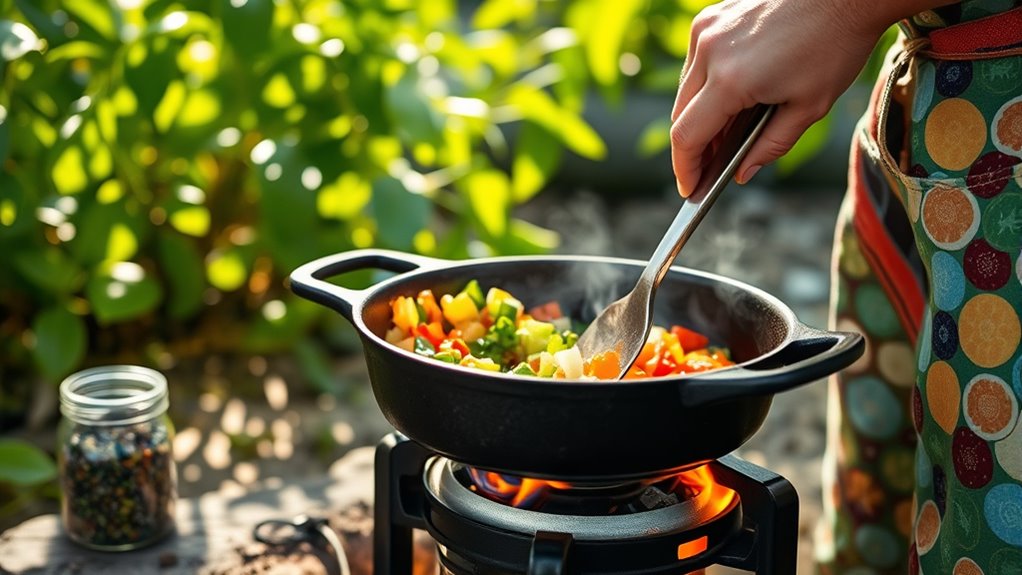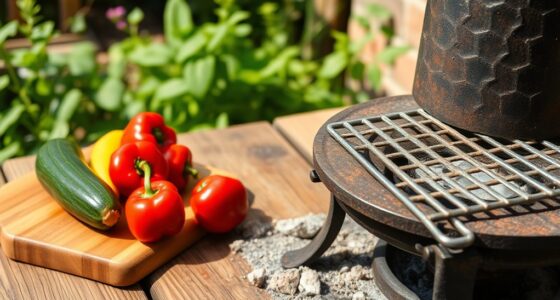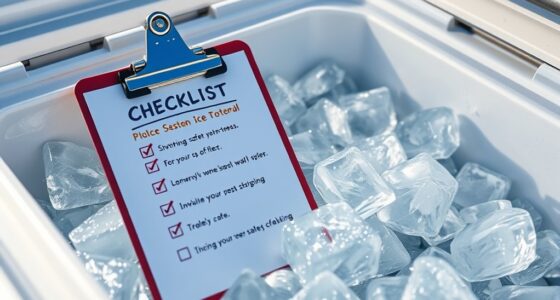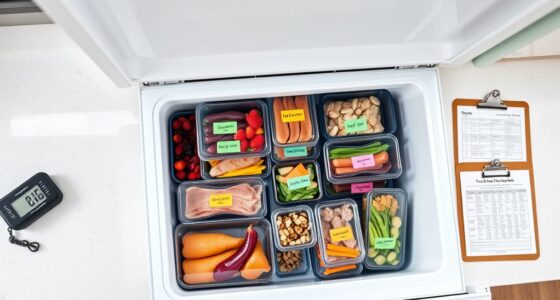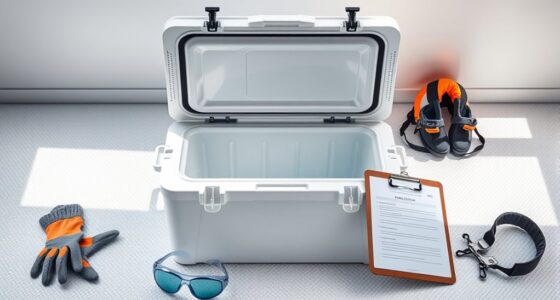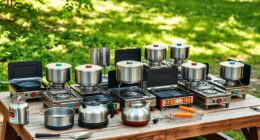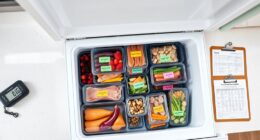In an emergency, you can quickly prepare safe, nutritious meals within 15 minutes using portable gas stoves, camping burners, or even a cast iron skillet on alternative heat sources like fire pits or solar cookers. No-cook options with shelf-stable ingredients, plus cold-prep breakfasts, make meal prep even easier. Keep safety in mind by inspecting devices and ensuring proper ventilation. Stick with these tips, and you’ll discover more ways to cook safely without power in a pinch.
Key Takeaways
- Use portable gas stoves or rocket stoves safely outdoors or in well-ventilated areas, inspecting for leaks and keeping flammable materials away.
- Prepare no-cook meals with shelf-stable ingredients like canned beans, tuna, and dried fruits for quick assembly.
- Leverage solar cookers and refrigerated coolers to safely prepare and store food without power, optimizing sunlight and temperature control.
- Employ handheld butane torches for precise heating, sealing, or finishing dishes, ensuring proper ventilation and safety precautions.
- Keep cleanup simple by using minimal equipment, disposable utensils, and organizing ingredients for quick, safe post-cooking tidying.
Using a Portable Gas Stove Safely

When using a portable gas stove, safety should always come first to prevent accidents or injuries. Always check for gas leaks before igniting the stove—listen for hissing sounds or apply soapy water to connections to spot bubbles. Keep the stove on a stable, flat surface away from flammable materials. Practice good gas stove safety by never leaving it unattended while lit. Regular portable stove maintenance is essential; clean the burners and check hoses for cracks or damage regularly. Use the stove in well-ventilated areas to avoid gas buildup. Ensure the fuel canister is properly attached and turned off when not in use. Proper venting and secure installation are crucial for safety and efficiency installation requirements. Following these safety tips helps you enjoy cooking outdoors or during emergencies without risking harm.
Preparing No-Cook Meals With Shelf-Stable Ingredients
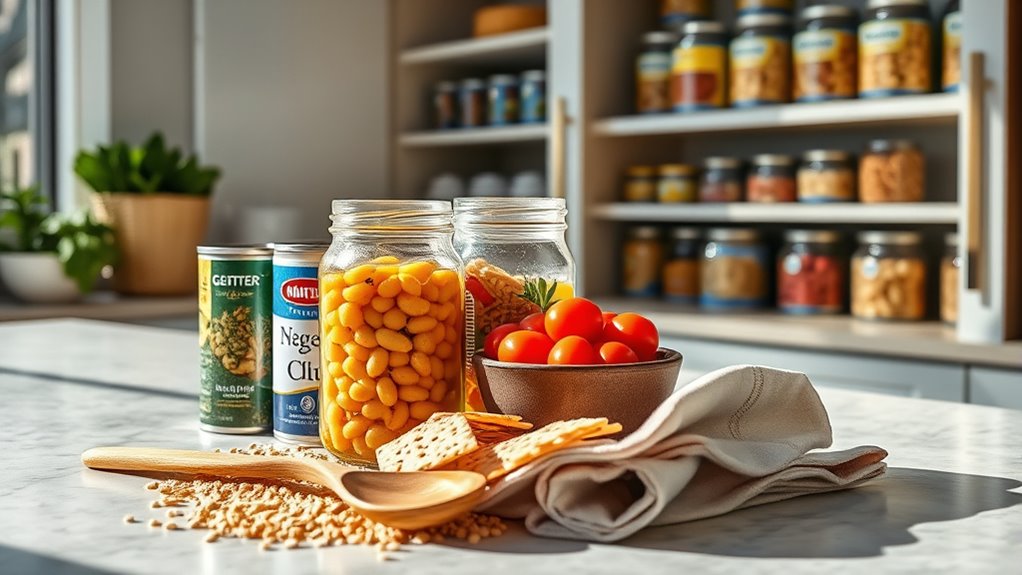
After ensuring your cooking area is safe and ready, you can turn your attention to preparing satisfying meals without the need for heat. Using shelf-stable ingredients is a smart way to maintain food preservation and reduce waste. Keep your pantry well-organized, so you can quickly find canned beans, tuna, dried fruits, nuts, and other essentials. Combine these ingredients into salads, wraps, or bowls—no cooking required. Proper kitchen organization helps you access everything easily and streamlines meal prep. Use resealable containers or jars to keep ingredients fresh and visible. This approach minimizes clutter and makes it simple to assemble nutritious, no-cook meals in minutes. Additionally, understanding self watering plant pots can inspire you to set up efficient storage solutions that keep your ingredients fresh and accessible. With a bit of planning, you’ll enjoy safe, tasty food without power or heat.
Mastering the Art of Solar Cooking

To master solar cooking, you need to understand different types of solar cookers and how to set them up effectively. You’ll also want to recognize the best sun conditions to make certain your meals cook quickly and safely. With the right knowledge, you can make the most of sunny days for effortless, power-free cooking. Additionally, understanding solar cooker tuning can help optimize your setup for better heat retention and cooking efficiency.
Solar Cooker Types
Understanding the different types of solar cookers is essential for mastering safe, power-free cooking. There are several designs suited for various needs and environments. The most common include box cookers, panel cookers, and parabolic cookers. Box cookers trap heat efficiently, making them great for slow cooking and baking. Panel cookers use reflective surfaces to concentrate sunlight onto a pot, offering portability and simplicity. Parabolic cookers focus sunlight into a tight point for quick, high-temperature cooking, ideal for frying or boiling. When choosing a solar cooker, consider solar panel maintenance to keep reflectors clean and efficient. If you want to store energy, explore battery storage options, although most basic models rely solely on direct sunlight. Understanding these types helps you select the best cooker for safe, reliable use. Incorporating self-reflection into your solar cooking routine can enhance your awareness of efficiency and safety practices.
Optimal Sun Conditions
Achieving ideal solar cooking depends on capturing the sun’s energy at its strongest, which means you need to be aware of the best conditions for sunlight. Check the weather forecast daily to identify clear, sunny days with minimal cloud cover. The clearer the sky, the more solar radiation reaches your cooker, increasing efficiency. Position your solar cooker to face the sun directly, adjusting as it moves across the sky. If you’re using a solar panel for supplementary power, ensure it’s also maximally aligned to maximize sunlight absorption. Avoid cooking during overcast days or when the sun is low on the horizon, as these conditions reduce heat. Monitoring solar energy trends can help you understand optimal sun conditions and improve your solar cooking results consistently.
Utilizing Fire Pits and Campfires for Quick Meals
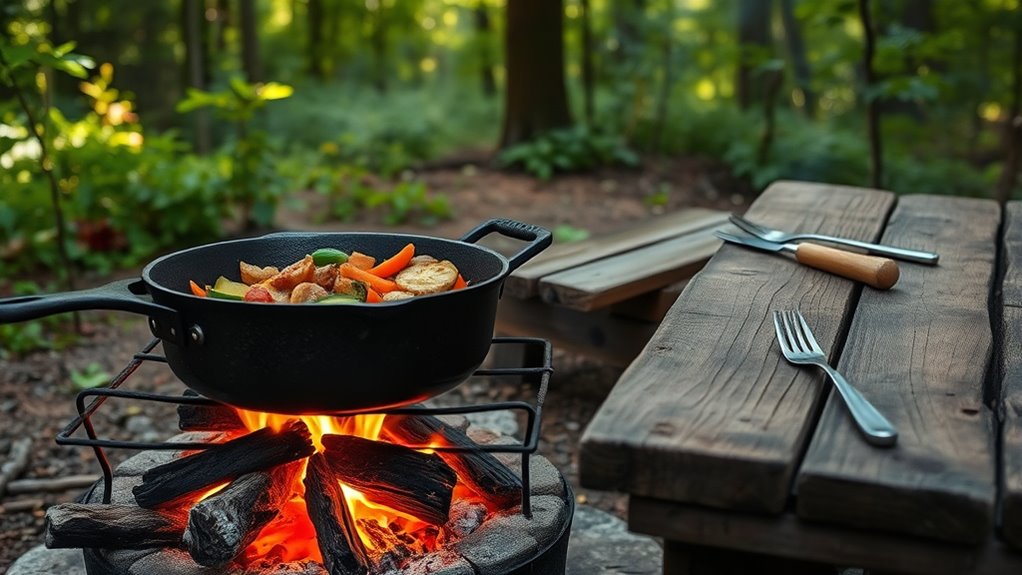
Setting up your fire pit or campfire safely is essential before cooking. Make sure the area is clear, and you have a stable, controlled flame to work with. Once ready, use quick-cooking techniques like skewering or foil packets to prepare your meals efficiently. Applying best practices in safety ensures a smooth and enjoyable cooking experience outdoors.
Safety Precautions and Setup
Before lighting a fire pit or campfire, you should always prioritize safety by choosing a clear, flat area away from overhanging branches, structures, or dry leaves. This minimizes fire risks and guarantees safe fire safety practices. Always check that your equipment is well-maintained—inspect the fire pit or grill for cracks, rust, and loose parts. Keep a bucket of water, a shovel, and a fire extinguisher nearby for emergencies. Clear the surrounding area of debris and flammable materials. Never leave the fire unattended, and fully extinguish it before leaving. Proper setup and ongoing equipment maintenance help prevent accidents and ensure safe, effective cooking. Regularly inspect your fire safety equipment to ensure it functions properly in case of an emergency. Remember, safety is key to enjoying quick, power-free meals without risking fires or injury.
Fast Cooking Techniques
Using fire pits and campfires can be a game-changer when you need to whip up a quick meal without power. These methods allow you to cook efficiently, saving time and energy. To maximize speed, keep your kitchen organized by pre-portioning ingredients and having tools ready. Fire-based cooking also offers opportunities for food preservation, like smoking or drying foods for later use. Use sturdy cookware designed for open flames to ensure safety and even heat distribution. Remember, quick cooking doesn’t mean sacrificing safety; always monitor flames and keep a fire extinguisher nearby. With proper planning, fire pits and campfires become reliable, fast options for satisfying meals during emergencies or outdoor adventures. They’re perfect for making the most of limited resources while maintaining food safety and organization.
Employing a Camping Stove for Fast, Safe Dishes
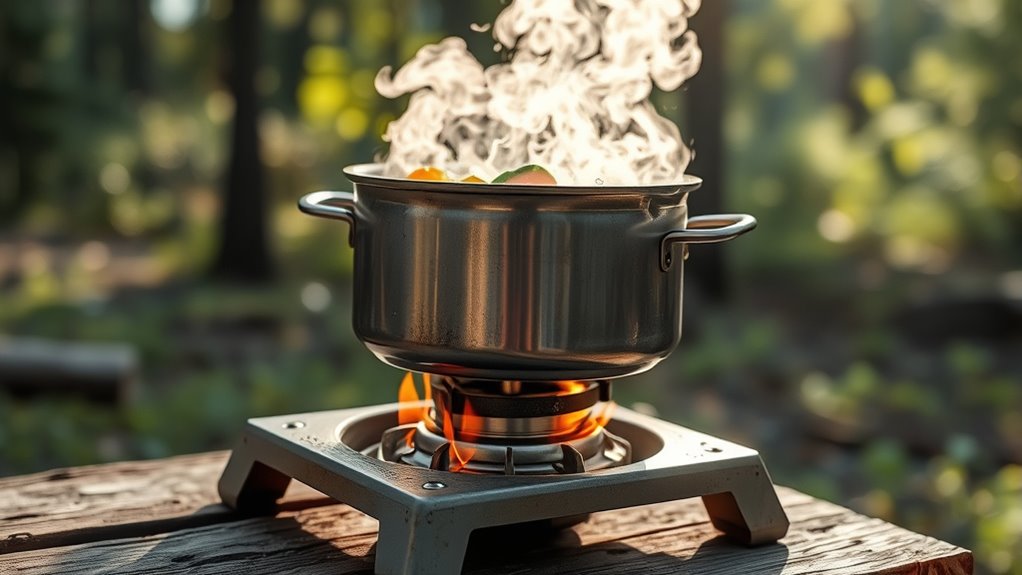
A camping stove offers a quick and reliable way to prepare safe, hot meals when power is out. You can cook dishes rapidly, whether you’re boiling water, sautéing ingredients, or reheating leftovers. For example, microwave heating isn’t an option without power, but your camping stove provides instant heat. To diversify your meals, consider oven baking in a portable oven attachment or using foil packs over the flame. Keep safety in mind by always monitoring your stove and using stable surfaces. Here are some tips to maximize efficiency:
- Use lightweight, pre-measured ingredients
- Prepare one-pot meals for quick cleanup
- Keep fuel sources accessible and full
- Pre-cook larger portions when possible
- Store easy-to-reheat foods for convenience
- Be aware of fuel options and select the best type for your camping stove.
Harnessing the Power of a Rocket Stove
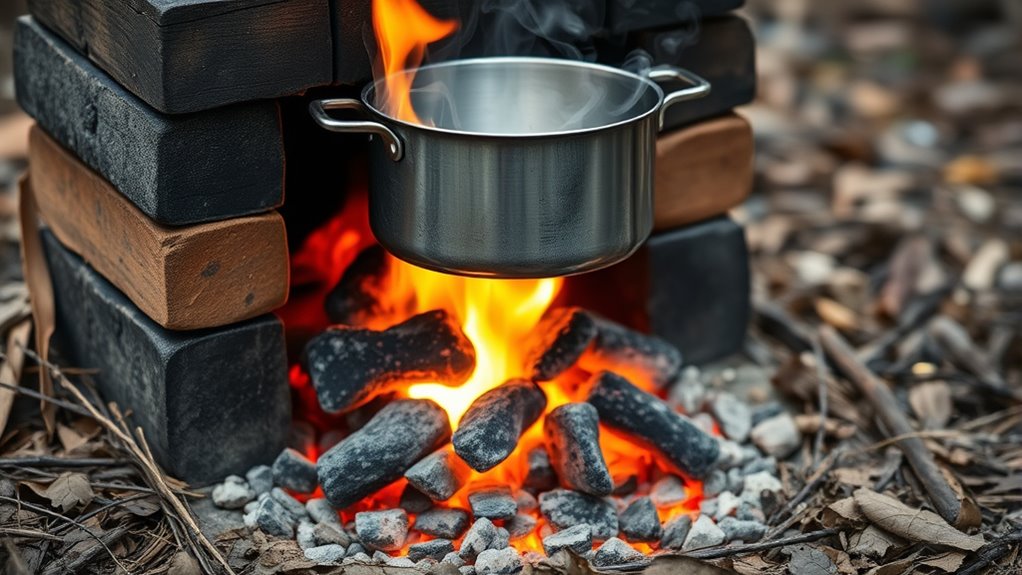
A rocket stove maximizes fuel efficiency, so you get more heat with less wood or biomass. Its compact design makes it easy to set up and store, even in tight spaces. By harnessing these benefits, you can cook safely and quickly without relying on power. Additionally, its simple construction allows for easy maintenance and cleaning, ensuring long-term reliable use.
Efficient Fuel Use
When you harness the power of a rocket stove, you maximize fuel efficiency by directing airflow and combustion to burn fewer resources while generating more heat. This method promotes resource conservation and reduces the amount of fuel needed for cooking. To improve efficiency, guarantee your stove is well-built with proper insulation and a tight seal. Use dry, seasoned wood or biomass, which burns cleaner and produces more heat. Manage your fire carefully, avoiding overloading the stove. Additionally, focus on cooking tasks that make the best use of heat retention, such as simmering or boiling in a covered pot. Optimal fuel selection can significantly enhance overall efficiency and reduce emissions.
- Use small, manageable pieces of fuel for quick ignition
- Maintain proper airflow for complete combustion
- Insulate the stove to retain heat longer
- Avoid unnecessary opening of the combustion chamber
- Combine multiple pots to maximize heat use
Compact Design Benefits
The compact design of a rocket stove allows you to maximize space efficiency while still delivering powerful heating performance. Its space-saving design makes it ideal for small kitchens or outdoor setups, where every inch counts. You can easily incorporate the stove into your existing cooking area without sacrificing valuable storage. The lightweight, streamlined structure enables quick setup and transport, making it perfect for emergency situations or outdoor cooking. With its minimal footprint, you can store it conveniently when not in use, freeing up valuable space. The efficient use of space ensures you don’t need bulky equipment, and the compact storage options keep your cooking area tidy. Overall, this design enhances your ability to cook safely and effectively, even in limited spaces.
Making Delicious Wraps and Sandwiches in Minutes
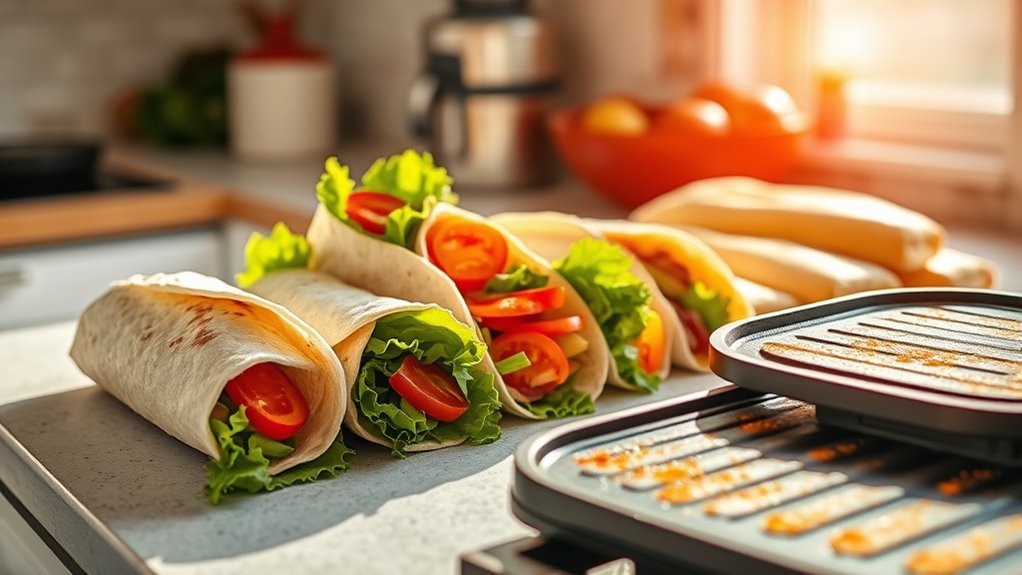
Even with limited resources, you can whip up tasty wraps and sandwiches in just minutes by choosing quick-prep ingredients and simple techniques. Focus on versatile wrap fillings like deli meats, cheese, fresh vegetables, or hummus. Select bread options that don’t require heating, such as pita, flatbreads, or sturdy sandwich loaves. To enhance flavor and texture, consider adding spreads, pickles, or herbs. Keep ingredients prepped and organized for quick assembly. Use a clean, flat surface for easy rolling and stacking. Here are some tips to make the process smoother:
Create quick, tasty wraps with prepped ingredients, sturdy bread, and simple rolling techniques.
- Keep pre-sliced deli meats and cheeses handy
- Use sturdy bread options for easy handling
- Incorporate crunchy vegetables for texture
- Layer sauces or spreads evenly
- Roll tightly to prevent fillings from spilling
Cooking With a Car Fridge or Cooler
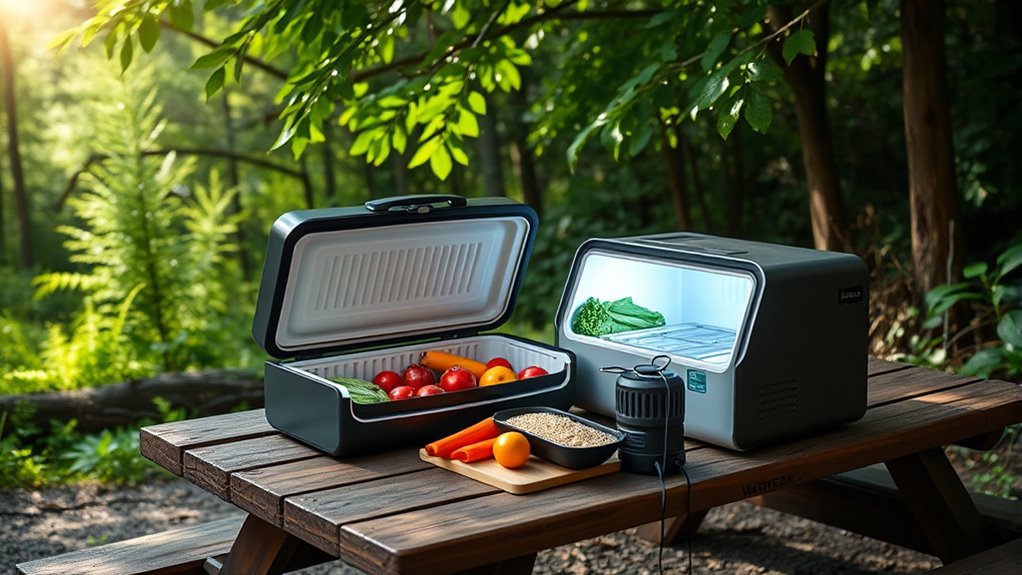
Using a car fridge or cooler to cook and store food extends your meal options beyond quick wraps. With a reliable cooler, you can keep ingredients fresh and chilled, making meal prep easier. Battery powered blenders are handy for smoothies or mixing ingredients directly in your cooler, saving space and energy. Reusable ice packs help maintain low temperatures, ensuring your food stays safe and fresh longer. You can even prepare salads, marinate meats, or keep cooked leftovers cold until you’re ready to eat. This setup is perfect for quick, safe meals without power, especially during outdoor adventures or emergencies. Just remember to check the temperature regularly and keep your cooler sealed to prevent spoilage, making your meal prep safer and more versatile.
Using a Handheld Butane Torch for Quick Sealing and Heating

A handheld butane torch offers a quick and effective way to seal bags, heat food, or create a crispy finish without needing electricity. Its precise flame allows you to target specific areas, ensuring safety and accuracy. With good heat control, you can avoid burning or overcooking your food. To maximize its benefits, consider these tips:
- Adjust the flame size for delicate tasks
- Use a steady hand to prevent accidents
- Keep the torch at a safe distance for even heating
- Work in a well-ventilated area to avoid fumes
- Practice on scrap material to master control
This tool is versatile for sealing snacks or adding a crispy touch to dishes, making it ideal for quick, power-free cooking.
Preparing One-Pot Meals With Minimal Equipment
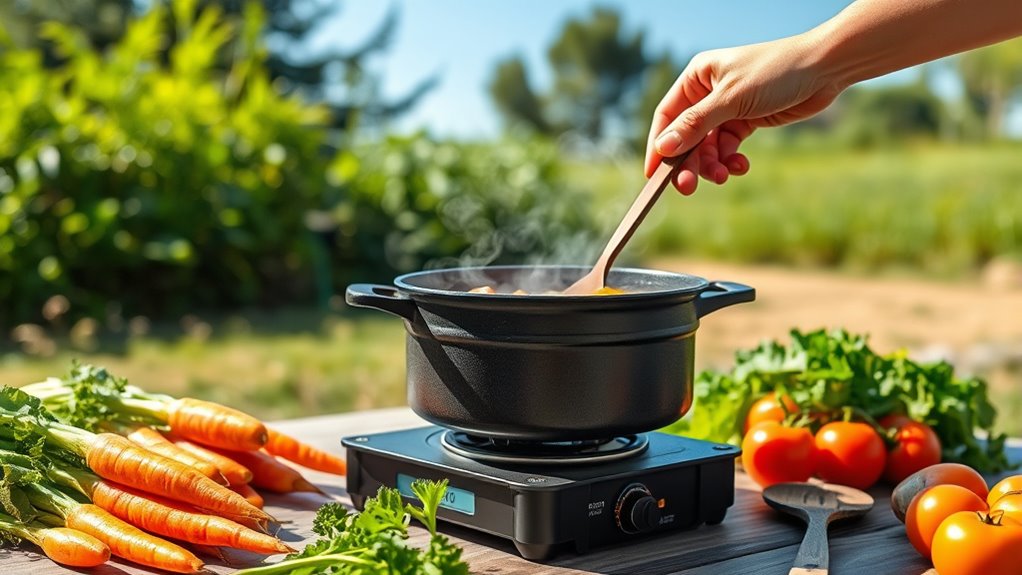
You can create satisfying one-pot meals with just a few simple ingredients and minimal equipment. Using efficient cooking techniques helps you save time and energy, even without power. Cleanup is easy when you choose the right methods and keep your setup simple.
Simple Ingredient Selection
Choosing the right ingredients is key to making quick, satisfying one-pot meals with minimal equipment. Focus on ingredient freshness to assure flavor and safety, especially when cooking without power. Select spices carefully; a good spice selection can elevate simple ingredients and add depth. Use versatile, long-lasting items like canned beans, dried herbs, and root vegetables that don’t spoil quickly. Opt for pre-washed greens or frozen vegetables to save prep time. Keep your pantry stocked with essentials like rice, pasta, and broth for quick assembly. Prioritize fresh, quality ingredients for the best taste, and choose spices that complement your main components. This approach simplifies cooking, reduces waste, and guarantees flavorful, nourishing meals even in emergencies.
Efficient Cooking Techniques
Mastering efficient cooking techniques can considerably cut down your meal preparation time, especially when using minimal equipment. One-pot meals are perfect for this. Use your electric stove to combine ingredients in a single pot, reducing the need for multiple dishes and cleanup. Start by adding ingredients that take longer to cook, such as grains or root vegetables, and then layer in quicker-cooking items. A microwave oven can speed up prep work, like softening vegetables or melting butter, saving stove time. Stir occasionally to prevent sticking or burning. Keep your ingredients organized to streamline the process. By focusing on minimal equipment and smart timing, you’ll prepare hearty, safe meals quickly without sacrificing quality or safety. This approach maximizes your limited resources and keeps cooking simple and efficient.
Easy Cleanup Methods
Preparing one-pot meals is one of the easiest ways to keep cleanup quick and simple. With minimal equipment, you reduce mess and save time. To make cleanup even easier, use cleaning with vinegar to break down food residues and disinfect surfaces. After cooking, soak your pot in warm water with vinegar to loosen stuck-on bits. For drying techniques, wipe the cookware with a clean towel or use a quick air drying method to prevent rust. Keep utensils and surfaces tidy during cooking to avoid buildup. Consider lining your pot with parchment paper or using silicone lids to minimize mess. By planning ahead and focusing on simple cleaning methods, you’ll spend less time scrubbing and more time enjoying your meal.
Safe Use of Charcoal Grills Indoors and Outdoors
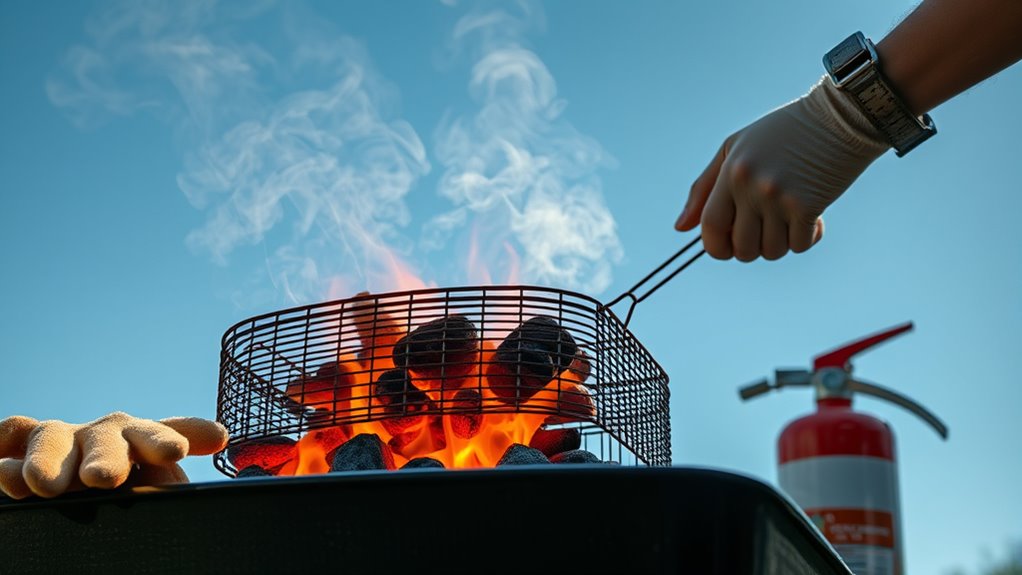
While charcoal grills can be great for outdoor cooking, using them safely is essential to prevent fires and health hazards. Always set up your grill on a stable, non-flammable surface away from structures, trees, and overhanging branches. Never use charcoal grilling indoors, as the smoke and carbon monoxide pose serious risks. If you’re grilling outdoors, keep a fire extinguisher nearby and never leave the grill unattended. Confirm the coals are completely cooled before disposing of ashes in a metal container. Use proper ventilation to avoid smoke buildup, and avoid using lighter fluid excessively. Following these safety tips helps you enjoy outdoor cooking with charcoal responsibly, reducing risks and ensuring a safe, pleasant grilling experience.
Leveraging Instant Pot or Manual Pressure Canners Without Electricity
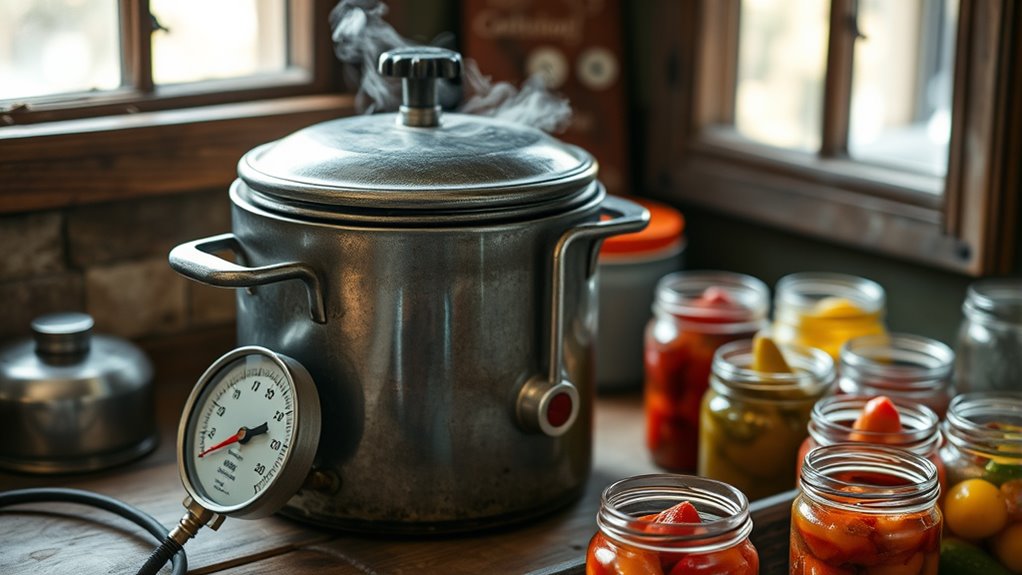
Even if the power goes out, you can still safely preserve food using an Instant Pot or manual pressure canner. These tools enable pressure canning and electric free sterilization, guaranteeing your food stays safe without electricity. You can process jars effectively on a gas stove or open flame, maintaining food safety standards. To do so, remember to monitor pressure levels carefully during the process. Here are some tips to optimize your pressure canning efforts:
Even during a power outage, pressure canning on a gas stove keeps your food safe and preserved.
- Use a compatible pressure gauge to ensure accuracy.
- Maintain a steady heat source for consistent pressure.
- Follow proper sterilization procedures before canning.
- Use durable, heat-safe canning jars designed for pressure canning.
- Keep a backup heat source, like a camp stove, for continuous operation.
Creating Cold-Prep Breakfasts and Snacks
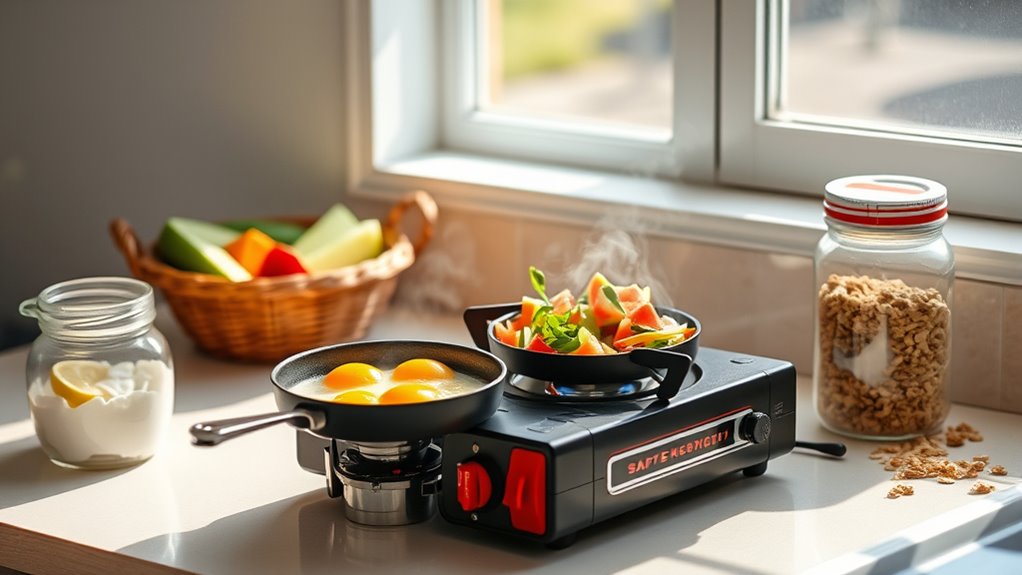
After preserving your food safely with pressure canning methods, you can expand your meal options by creating cold-prep breakfasts and snacks that require minimal effort. For a quick start, prepare cold oatmeal the night before by soaking oats in milk or a dairy-free alternative. In the morning, add fresh fruit, nuts, or honey for flavor. Yogurt parfaits are also easy—layer yogurt with granola and berries in a jar or cup, then refrigerate. Both options are portable, nutritious, and don’t need heating. These meals stay fresh in your fridge and take just minutes to assemble. They’re perfect for busy mornings or when power is out, offering a safe, satisfying way to start your day without cooking.
Using a Cast Iron Skillet on Alternative Heat Sources
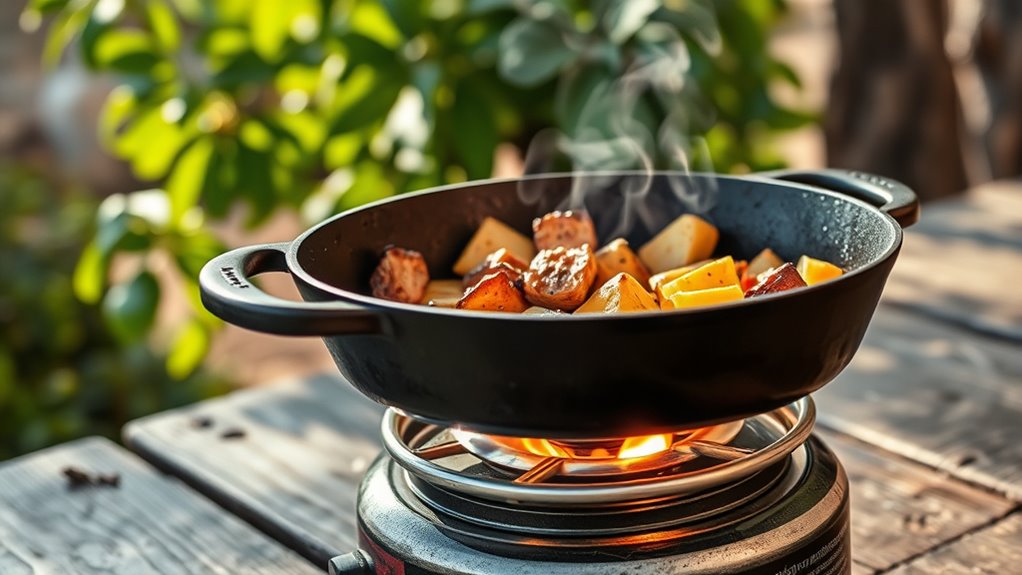
A cast iron skillet is a versatile tool that can be used effectively on alternative heat sources when traditional stovetops aren’t available. To get the best results, ensure your skillet is well-maintained and properly seasoned. Before cooking, check that your skillet’s surface is smooth and free of rust, which can affect heat distribution. Use appropriate heat sources like camp stoves, open fires, or portable burners, adjusting heat carefully to prevent damage. Remember, good cast iron maintenance and seasoning techniques are essential for longevity and performance.
- Use a heat diffuser to prevent hotspots
- Preheat gradually to avoid warping
- Clean with minimal soap, dry thoroughly
- Re-season regularly for a non-stick surface
- Avoid sudden temperature changes to prevent cracking
Tips for Ensuring Safety During Power-Free Cooking
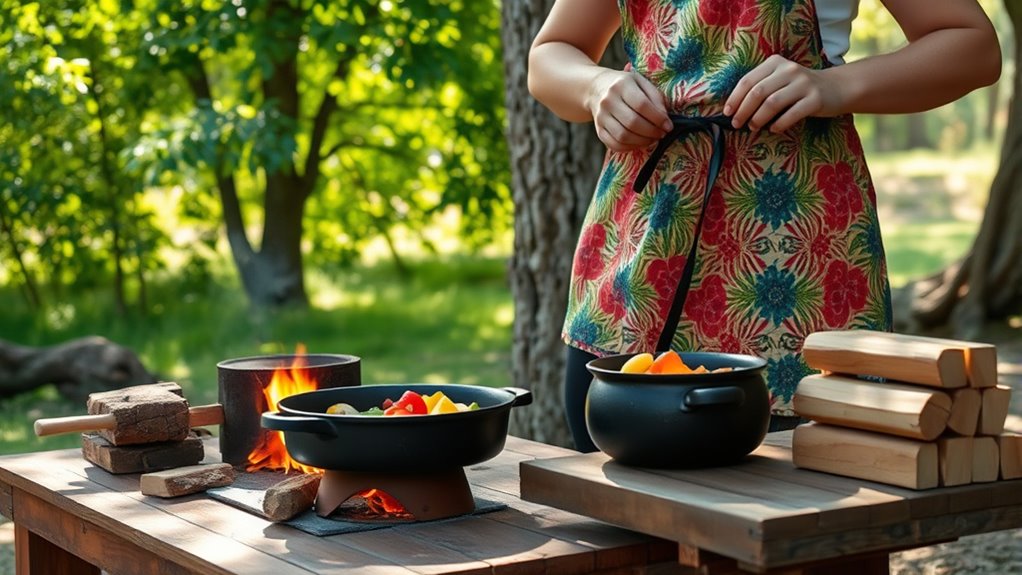
When cooking without power, prioritizing safety is essential to prevent accidents and injuries. Make certain your indoor safety measures are in place before you start. Keep a fire extinguisher nearby and know how to use it, just in case. Always cook in a well-ventilated area to prevent smoke buildup, especially when using open flames or alternative heat sources. Avoid loose clothing and keep flammable materials away from heat sources. Never leave cooking unattended, and double-check that your heat source is stable. Clear the area of clutter to reduce fire risks. By maintaining indoor safety practices, you create a safer environment, minimizing hazards during power-free cooking. Being prepared and cautious helps you enjoy your cooking experience safely.
Frequently Asked Questions
What Are the Best Practices for Storing Fuel Safely During Outdoor Cooking?
You should store fuel in a well-ventilated, cool, and dry area, away from direct sunlight and heat sources. Use approved, tightly sealed fuel containers to prevent leaks and spills. Follow outdoor storage tips like keeping containers upright and away from flames or sparks. Always label your fuel containers clearly, and never store fuel inside your home. These practices ensure fuel container safety and reduce the risk of accidents during outdoor cooking.
How Can I Prevent Cross-Contamination When Preparing No-Cook Meals?
To prevent cross-contamination when preparing no-cook meals, focus on food hygiene and kitchen sanitation. Always wash your hands thoroughly before handling ingredients, and use clean utensils and cutting boards for each item. Keep raw and cooked foods separate, and store ingredients properly to avoid bacterial transfer. Regularly disinfect surfaces and wash fruits and vegetables carefully. These steps help maintain a safe environment and prevent foodborne illnesses.
What Are the Environmental Considerations of Using Different Outdoor Cooking Methods?
Your outdoor cooking choices can impact the environment more than you realize. Solar energy is a powerhouse, offering clean, renewable power that leaves no fuel emissions behind. Using traditional fuels releases pollutants and contributes to climate change. Opting for solar cookers minimizes your carbon footprint and helps protect our planet. By choosing eco-friendly methods, you become a hero fighting environmental damage—your actions truly can change the world!
How Do I Troubleshoot Common Issues With Portable Gas Stoves?
When troubleshooting your portable gas stove, start by checking for a fuel leak around the connections; if you smell gas, tighten or replace the faulty parts. For ignition failure, ensure the spark igniter is clean and properly aligned. If it still won’t ignite, test the battery or replace it. Always turn off the stove and disconnect the fuel source before inspecting or fixing to stay safe.
What Safety Gear Should I Have on Hand for Power-Free Cooking Emergencies?
You should keep a fire extinguisher nearby, especially one rated for kitchen fires, and familiarize yourself with fire extinguisher tips for quick response. Also, have first aid essentials on hand, including bandages, antiseptics, and burn ointments, to handle minor injuries promptly. Wearing heat-resistant gloves and ensuring proper ventilation can also prevent accidents. Being prepared with these safety gear essentials helps you respond effectively during power-free cooking emergencies.
Conclusion
With these quick, power-free cooking hacks, you can turn any 15-minute meal into a culinary adventure that rivals gourmet restaurants. Whether you’re using a portable stove, solar cooker, or fire pit, you hold the power to create delicious, safe dishes anytime, anywhere. Embrace these methods, stay safe, and prove that you’re a kitchen ninja capable of conquering any culinary challenge—power outage or not! Your next great meal is just a few minutes away.
